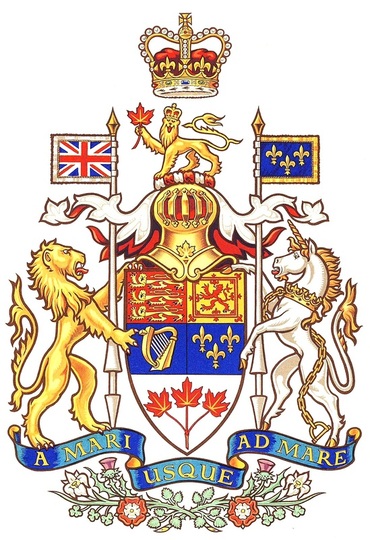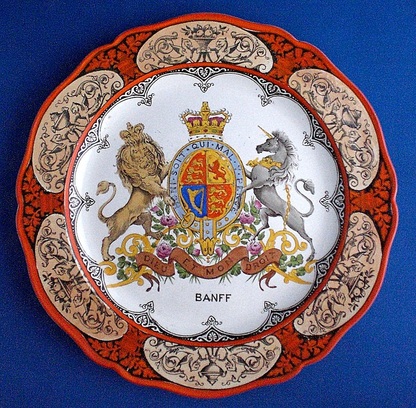Heraldic Anachronisms in Movies and Television Series
Auguste Vachon, Outaouais Herald Emeritus
An amusement of heraldists is to detect heraldic discrepancies in movies and television series. For instance, in The Untouchables (1987), Eliot Ness (Kevin Costner), intercepts a shipment of whisky from Canada during prohibition. The year cannot be latter than 1933 when prohibition ended in the United States, yet the whisky crates are marked with the 1965 stylized maple leaf of Canada’s flag, which is so unique that it cannot be replicated by chance. Pirates of the Caribbean: On Stanger Tides (2011) features a race between England and Spain to find the Fountain of Youth. The action takes place during the reign of King George II (1727-1760) when the United Kingdom was represented on the Union Flag (Jack) by the red cross of St. George (England) and the white saltire of St. Andrew (Scotland). Nevertheless, the ship commanded by Captain Hector Barbossa (Geoffrey Rush) flies at the stern the present Union Flag with the three crosses it has today. The third cross, the red saltire of St. Patrick (Ireland), was added in 1801 only, at the time of George III. Towards the end of the movie, a British soldier displays the same flag full length and proclaims: “This land is hereby forever claimed in the glorious name of His Majesty King George.”
Does ignorance account for the flag blunder? The fact that the soldier so blatantly displays the present Union Flag as if to say “Can’t you see what’s going on? Stupid!” leads us to believe that the filmmakers are poking fun at the audience. The same spirit of jest reappears when Jack Sparrow (Johnny Depp) reads aqua de vida on the chalices, an inscription which combines Latin with Spanish, the Latin for “water of life” being aqua vitae (also an ardent spirit) and the Spanish agua de vida. Could it be that aqua was the proper word at the time of Ponce de León (c. 1460-1521) on whose ship the chalices were found? Early Spanish literary works, such as the poem Denuestos del agua y del vino (Debate between water and wine) which is dated c. 1205, confirm that agua predates Ponce de León by centuries. It seems likely that Penélope Cruz, one of the stars of the movie, would have sought to rectify this affront to the Spanish language had it not been intentional, as was undoubtedly the prank with the flag.
More recently a glaring anachronism―at least for those familiar with Canada’s coat of arms―appeared several times in the popular Canadian television series “Murdoch Mysteries.” It seems that every time there is a court appearance on this series, the judge is sitting in front of Canada’s arms as they were redesigned by Alan Beddoe in 1957 (fig. 1). This happened in “On the Waterfront” part II in which suffragettes were brought before the court and again in the episode where William Murdoch and Dr. Julia Ogden are joined in holy matrimony. Since the series takes place in the early twentieth century, the 1957 version of Canada’s emblem is very much out of its time period. At the dawn of the twentieth century, the arms displayed in Canadian courts were the royal arms of the United Kingdom, which have retained the same components since 1837 (fig. 2).
After Canada acquired royal arms of its own in 1921, the former royal emblem was mostly replaced by the new one in Canadian courts. However the old royal arms are still displayed in British Columbia courts, in the Supreme Court of Newfoundland and Labrador, over the dais of the Court of Appeal for Ontario at Osgoode Hall, as well as in the Nova Scotia Court of Appeal located in the modern setting of the Law Courts building in Halifax. Perhaps for future court appearances that are not already filmed, the producers will choose an appropriate older courtroom with the royal arms of the United Kingdom.
Does ignorance account for the flag blunder? The fact that the soldier so blatantly displays the present Union Flag as if to say “Can’t you see what’s going on? Stupid!” leads us to believe that the filmmakers are poking fun at the audience. The same spirit of jest reappears when Jack Sparrow (Johnny Depp) reads aqua de vida on the chalices, an inscription which combines Latin with Spanish, the Latin for “water of life” being aqua vitae (also an ardent spirit) and the Spanish agua de vida. Could it be that aqua was the proper word at the time of Ponce de León (c. 1460-1521) on whose ship the chalices were found? Early Spanish literary works, such as the poem Denuestos del agua y del vino (Debate between water and wine) which is dated c. 1205, confirm that agua predates Ponce de León by centuries. It seems likely that Penélope Cruz, one of the stars of the movie, would have sought to rectify this affront to the Spanish language had it not been intentional, as was undoubtedly the prank with the flag.
More recently a glaring anachronism―at least for those familiar with Canada’s coat of arms―appeared several times in the popular Canadian television series “Murdoch Mysteries.” It seems that every time there is a court appearance on this series, the judge is sitting in front of Canada’s arms as they were redesigned by Alan Beddoe in 1957 (fig. 1). This happened in “On the Waterfront” part II in which suffragettes were brought before the court and again in the episode where William Murdoch and Dr. Julia Ogden are joined in holy matrimony. Since the series takes place in the early twentieth century, the 1957 version of Canada’s emblem is very much out of its time period. At the dawn of the twentieth century, the arms displayed in Canadian courts were the royal arms of the United Kingdom, which have retained the same components since 1837 (fig. 2).
After Canada acquired royal arms of its own in 1921, the former royal emblem was mostly replaced by the new one in Canadian courts. However the old royal arms are still displayed in British Columbia courts, in the Supreme Court of Newfoundland and Labrador, over the dais of the Court of Appeal for Ontario at Osgoode Hall, as well as in the Nova Scotia Court of Appeal located in the modern setting of the Law Courts building in Halifax. Perhaps for future court appearances that are not already filmed, the producers will choose an appropriate older courtroom with the royal arms of the United Kingdom.
Fig. 1 Coat of arms of Canada as redesigned by Alan Beddoe in 1957. In use until 1996.
Fig. 2 The royal arms as represented from 1837 on a plate created for the tourist town of Banff (Alberta) by Wedgwood in 1922. Vachon Collection, Canadian Museum of History.

